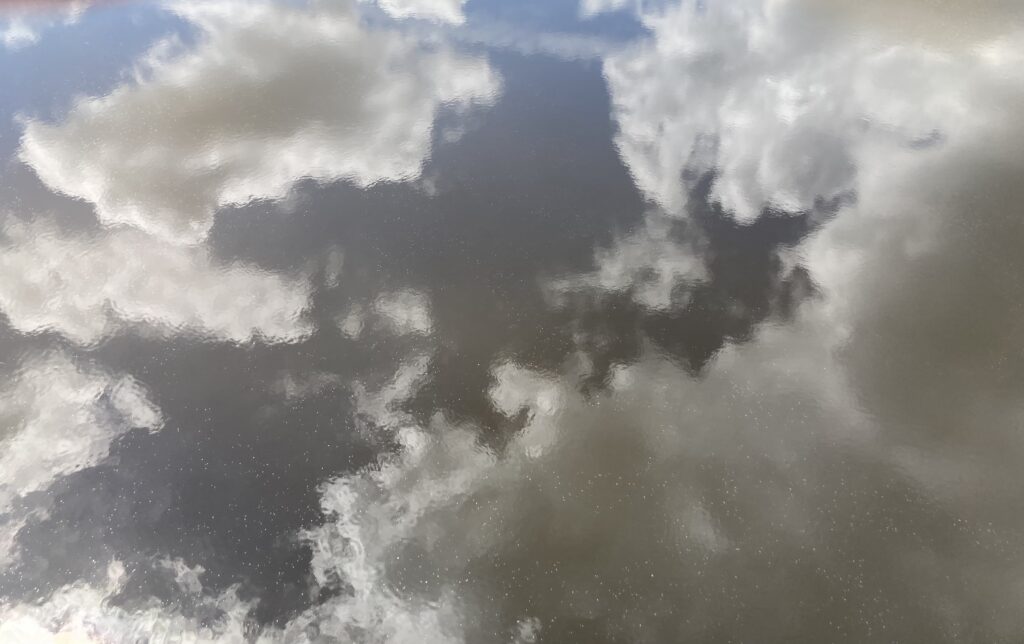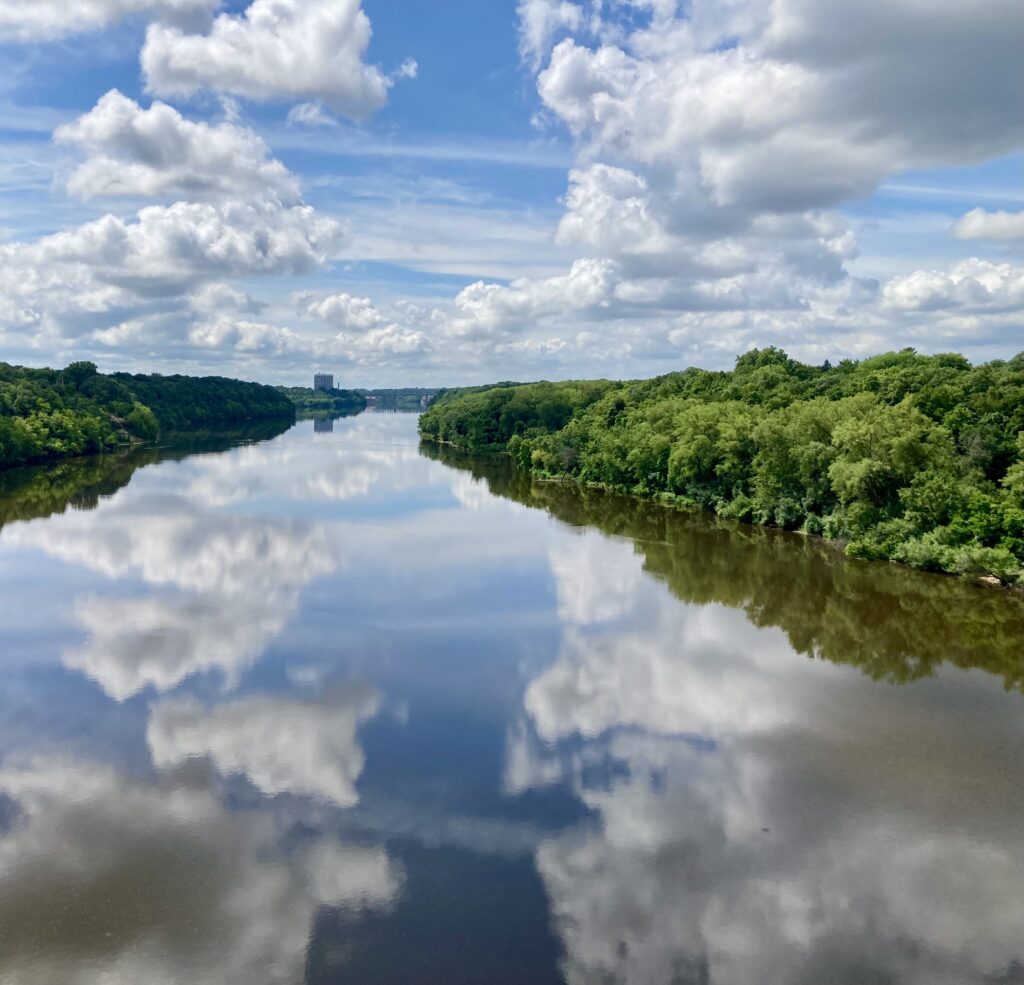run: 4 miles
the monument and back
73 degrees
dew point: 69
Thought about going out for a run around 6:30 am but watched Pogacar defend his yellow jersey in the alps instead. Excellent. Finally made it out for a run at 10:30. Not as bad as yesterday, but too warm, especially in the direct sun.
Chanted in triple berries. Admired the reflections of clouds on the river. Heard the kids on the playground at the church preschool. Put in the soundtrack to “Operation Mincemeat” for the second half.
I thought briefly about fields — visual and of tall grass and open vistas — and buoys and dots and simple forms.
Walking home after the run, I noticed someone stopped on the corner with a dog. I wondered why they were stopped — was there a car coming? should I not cross? Got to the other side and realized that it was my son, FWA, and our dog, Delia. It’s happened before — just last week — but it’s always upsetting when I don’t recognize my kids or my husband or my dog. For a moment, they’re only strangers.
Crossing back over the lake street bridge, I took a few pictures of the clouds reflected on the river:


note: I had to crop out my finger from the left hand corner. Even with the cropping, I think these are cool pictures.
visual fields, landscapes, meadows
1
At the end of yesterday’s entry I wondered what sighting buoys and swimming in the lake had to do with the visual field test. I’m still thinking about it. On a literal level, the way I’ve trained myself to sight a buoy, lining up its path, then trusting myself to swim straight to it even when I can’t see it, is how I took the visual field test last month: I fixed on the center dot and looked straight at it, or where I knew it to be when I couldn’t see it. My eyes didn’t wander. Another connection: at a distance, the buoy doesn’t look like the shape that it is — a triangle — it looks like a small dot in the center of my vision.
2
Yesterday, reviewing early july entries, I encountered this definition of visual field: “that portion of space in which objects are visible at the same moment during steady fixation of the gaze in one direction.”
It reminded me of definitions of landscape I came across yesterday in the OED: “A view or prospect of natural inland scenery, such as can be taken in at a glance from one point of view.”
the space in which objects are visible at the same time, what all can be taken in (simultaneously) with one glance
3
as
though there
swung at the end
of a tunnel,
a passage dotted
with endless
points of
arrival, as
though our gaze
started just outside
our faces and
corkscrewed its way
toward the horizon,
processual,
as if looking
took time to happen
and weren’t
instantaneous,
offered whole in
one gesture
before we
ask, before our
will, as if the far
Sonoma mountains
weren’t equally ready
to be beheld as
the dead
fly on the sill)
(Pastoral/ Forrest Gander)
What I remember of better eyesight is how the world assembled all at once, an effortless gestalt—the light, the distance, the dappled detail of shade, exact crinkles of a facial expression through a car windshield, the lift of a single finger from a steering wheel, sunlight bouncing off a waxed hood.
(Naomi Cohn)
4
A quick glance — my eyes emerge from the water like an alligator to look ahead for the buoy. Often all I see is a green mass of trees and empty water. Occasionally, a bright dot, far off. I don’t see it every time I look, but enough times to keep steadily swimming towards it. No time to think, not enough data to be certain, but I believe it’s the buoy, and usually I’m right. A few times I’ve mistaken a bright swim cap or a car’s headlight or a sailboat for the buoy.
5
“A field is used more often to describe an area managed by people. The field before you was once an orchard and pasture belonging to a farmer. A meadow is used to describe a wild area.”
“Fields and meadows start when trees have been removed from an area. This can occur naturally with a forest fire or flood, or humans may cut down a forest. Seeds from grasses and weeds take root shortly after and a meadow is born.
As the trees within my macula disappear, my forest meadows. here I’m thinking about my classic memory from science class with the inverted tree in the back of the eye.
bike: 8 miles
lake nokomis and back
82 degrees / 79 degrees
Biked to the lake! No worries, felt relaxed and able to see well enough, or if I couldn’t see, able to navigate well enough. No moments of panic. Biking back was the best. Long shadows, cooler, people biking/walking/running and enjoying the calm evening. I admired the shadow of me on a bike, looking larger than life.
swim: 3 loops
lake nokomis open swim
82 degrees
Yesterday, open swim sent out a warning about blue-green algae. They weren’t closing the lake, just encouraging people to be cautious. I didn’t see any algae blooms, although I noticed that the water was a more vivid, electric green. The water was warm and calm and wonderful. With the sun, it was difficult to see — I could see dots, which I trusted were buoys as I swam towards the little beach, but swimming back towards the big beach, barely anything other than bright sun, sparkling water. I managed to see the buoys at least once and trusted my shoulders to guide me across. I don’t think I’ll ever not be amazed that this works, that I swim straight to the buoys when I can’t (or barely can) see them.
I tried something new as a I swam. Each time I tilted my head to breathe, I thought a word, usually 1 syllable but occasionally 2: squish flash flit fly flush flare zip zap bird tree cloud blue girl ghost gorge life death bliss breath bubbles bike run float lift shut jump black red orange feet toe hand face field grass give take spirit sprite light dark
There were many other words, but I don’t remember them all. I might try this again. Maybe some great words/images will burst out?!
images collected in consciousness
like a tree alone on the horizon
(Crows/ Marilyn Nelson)